Introduction
When, or even if, people learn about Borikén they are often provided with misinformation, half-truths, and blatant lies that intentionally obscure and conceal the true history of our country and our people. This document offers a comprehensive history of Borikén, beginning at the pre-colonial period and concluding with more recent events. Telling the people’s story and removing US propaganda, interests, and narratives is necessary in order to understand the past and fight for liberation today. Share this resource widely and allow it to deepen your knowledge of US imperialism and your commitment to Borikén’s liberation.
Part I: The Initial Colonization of the Taíno People and the Arrival of Enslaved Africans
Part II: The End of Spaniard Rule
Part III: The US Invasion of Borikén
Part IV: The Aftermath of the US Invasion and the Fight for Independence
Part V: Early 2000s and the Current Situation of Borikén
The Initial Colonization of the Taíno People and the Arrival of Enslaved Africans
Indigenous peoples of Borikén (Puerto Rico) are known as the Taíno (translating to good and noble) people, a subgroup of the Arawak people that inhabited many islands of the Caribbean including Cobao (Cuba), Ayiti (Haiti), Quisqueya (Dominican Republic), Xaymaca (Jamaica), and parts of Southern so called “Florida”. In the Antilles and Bahama, they were known as the Lucayans and spoke the Taíno language, one of the Arawakan languages. It is believed that as many as 3 million Taínos existed during this time.

During Cristóbal Colón’s invasion in 1492, there were multiple Taíno chiefdoms in Borikén. Each was led by a principal Cacique who was in charge of their Yukayekes or villages. Below the caciques were the Nitaíno who were representatives of the caciques. Following the Nitaíno were the Behikes, the herbalists who were admired greatly. The largest group was the Nabori, or the general working society of Borikén. Both men and women were eligible to serve as caciques and there was a democratic process to elect them. Contrary to popular belief, the Taínos of Borikén were a matriarchal society. The most notable female cacique was named Yuiza or Loíza. The importance of each cacique’s tribe was determined by size, not its war power. Ancestral lineage was traced through the mother as well as wealth, class status, and the potential to become cacique.
Zemís, not to be confused with gods, are the Taíno deities and ancestral spirits that rule the natural world. The first Zemí, Atabey, is the creator of the universe and the deity of land, fresh water, and fertility. Atabey had two twin sons, Yúcahu and Guacar. Yúcahu rules over the harvest (specifically cassava). Guacar was born to help create the universe along with Yúcahu and Atabey. Yúcahu had children of his own, Boinayel, controller of the moon and rain and Maroya, controller of the sun. Guabancex is the hurricane deity and is known for creating chaos and natural disasters.
Behikes consulted the Zemís for advice and healing. The Behikes used cohoba, a medicinal hallucinogen to travel to the spirit world and bring back knowledge, power, and healing to the people during their spiritual rituals. Another part of Taíno spiritual rituals were known as Areitos, or dances full of beating drums, maracas, oral traditions, and ball games between opposing teams using a rubber ball. Winning the game was thought to bring a good harvest and strong, healthy children.
The Taíno people practiced polygamy and it was common for both men and women to have multiple partners. The Taíno people were bronze-colored with average stature and had dark, coarse hair and large, slanted dark eyes.
The Taíno people were generally naked or wore a cloth nagua made of palm fibers with the length signifying the rank of the person. They painted themselves with jagua and annatto for aesthetic and spiritual reasons. They wore jewelry such as earrings, nose rings, and necklaces which were sometimes made of gold. The caciques specifically wore necklaces called Guanín, made of alloy hammered into ceremonial medallions. This signified the social and political power of the cacique and were exchanged to celebrate important events like marriages, alliances, and visits. They also wore Guaíza masks to embody the spirit of our beloved Zemís. The Guaíza masks are still used today in our vejigante festivals.
The Taíno people created pottery and baskets using mostly stone, marble, and wood to create sculptures of Zemís. Dujos were four-legged wooden stools with intricately carved backs that symbolized prestige as they were used by caciques and Behikes. They made hammocks (or hamacas) from cotton cloth and string that were used for sleeping. Some people lived with the cacique in large rectangular huts called caneyes. Caneyes were located in the center of the village and the rest of the tribe lived in bohíos. These round huts were framed with wood and had straw roofs, dirt floors, and an open interior. Bohíos were sturdy enough to resist hurricanes, but fell out of use after the late 1950’s.
Our people were an agricultural and hunting society as were excellent sailors, fishermen, and navigators. The Taíno developed the canoa, or canoe, a large dugout canoe used for transportation, fishing, and water sports. The main crops of the Taínos were cassava, garlic, potatoes, guava, and more. They used clay and wooden bowls for mixing and serving food. Higueras or gourds were used for drinking water, bailing out boats, musical instruments, and had religious significance. There was no calendar or writing system, but they counted using their hands and feet and created drawings and symbols that can be seen across the country today.
In 1493, Juan Ponce de León invaded Borikén under the Spanish crown, eventually becoming the first illegitimate governor of Borikén. Ponce de León also led the invasion of so-called “Florida”. He became a top military official in Hispaniola where he was tasked with crushing a rebellion of Taíno people. Afterwards, he led the initial colonial attacks on Borikén when he permitted the Spanish to “explore” Borikén in 1508. Ponce de León became rich off of the enslavement of the Taíno people forced to work in Spanish plantations and mines. Every Taíno older than fourteen was forced to find and give a certain amount of gold to the Spanish every few months. If they did not, the Spanish would cut off their hands. In 1511, Ponce de León lost the title of governor of Borikén to the son of Cristóbal Colón. Following this, Ponce de León decided to leave Borikén and colonize other places in the Caribbean.
Around this time, the Taíno people began to question the legitimacy of the Spaniards’ claim that they were immortal. In 1510, Cacique Urayoán and Cacique Agüeybaná II decided to test whether the Spaniards were in fact immortal. They took the Spaniard colonizer, Diego Salcedo, to the deepest part of a river and held him under water until he drowned. When the colonizer’s body began to rot, Urayoán proved to the rest of the Taíno people that the Spanish were not immortal. Revolts sprang up across Borikén. Ponce de León responded by killing approximately 6,000 Taínos to squash the resistance.
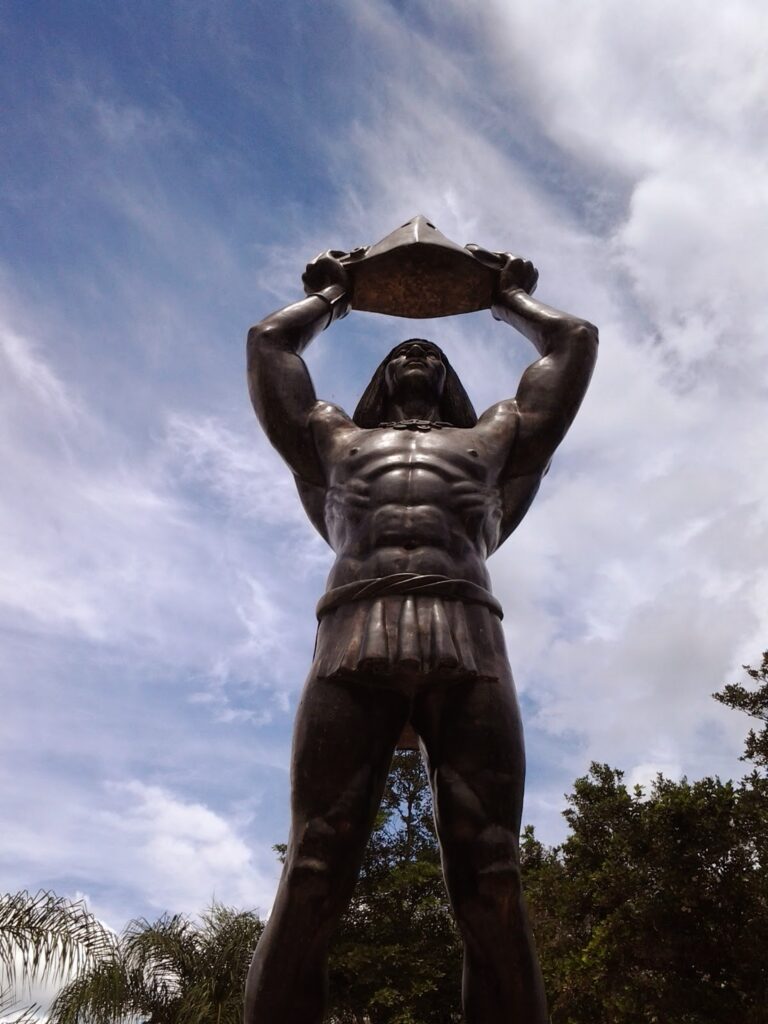
Cacique Urayoán

Cacique Agüeybaná II
Cacique Agüeybaná II was born around 1470 in Güeybaná and was often referred to as “Agüeybaná El Bravo”. He was one of the most powerful caciques when the Spaniards first invaded Borikén on November 19, 1493. Cacique Agüeybaná II led Taíno warriors in the Battle of Yagüecas, also known as the “ Taíno rebellion of 1511” against Juan Ponce de León and the Spanish colonizers.
Beginning in 1509, after many Taíno people were killed (largely from European disease), the Spanish colonizers brought enslaved Africans to replenish the forced laboring class harvesting sugarcane and coffee in Borikén.
In 1527, the first major slave rebellion took place when dozens of slaves fought against the Spanish colonizers. A few were able to retreat to the mountains where they resided with the surviving Taíno people. At least twenty revolts were carried out from this time period until March 22, 1873 when slavery was abolished by the Spanish National Assembly. However, slave owners were compensated with 35 million pesetas ($222,719.37 US dollars) per slave. Meanwhile, slaves were forced to continue working for three more years and had to buy their freedom at whatever price their masters chose. Today, colorism still exists towards Afro-Boricuas and requires constant attention and effort to dismantle and decolonize.
Bomba y plena, originates from enslaved Africans in Ponce. This music and dance is a source of political and spiritual expression. The lyrics convey both a sense of rage and despair as well as a call for uprising and rebellion against slavery. Today, bomba y plena is a celebration of Afro-Boricua identity, dignity, and culture.

A depiction of Bomba y Plena by Samuel Lind, an artist in Loíza
The End of Spaniard Rule
Ramón Emeterio Betances y Alacán, born in Cabo Rojo on April 8, 1827, was an independence advocate and medical doctor. He was the primary instigator of El Grito de Lares revolution (the first major revolt against Spanish rule in Borikén on September 23, 1868) and is considered to be the father of the Puerto Rican independence movement. He also became known as “El Padre de los Pobres” (The Father of the Poor) for his work and commitment to the masses. In late June 1867, Betances and at least twelve more revolutionaries, including the slave abolitionists Pedro Gerónimo Goyco and Segundo Ruiz Belvis, were exiled from Puerto Rico by Governor General José María Marchessi y Oleaga for their liberatory work.
Betances delivered many powerful pro-nationalist proclamations written from 1861 until his death in 1898. The most famous of these is “ Los Diez Mandamientos de los Hombres Libres” (The Ten Commandments of Free Men), written while in exile in Saint Thomas, November 1867.
Betances was also the founder of the Antillean Confederation, a regional entity that sought to preserve the sovereignty and well-being of Cobao, Ayiti, Quisqueya, and Borikén.

Ramón Emeterio Betances y Alacán
Lola Rodríguez de Tió, born on September 14, 1843 in San Germán, was a poet, abolitionist, women’s rights advocate, and independence fighter. Her and her husband, Eugenio Maria de Hostos, were both exiled alongside Betances. She became close with José Martí and other Cuban revolutionaries. Lola Rodríguez de Tió is credited with the design and colors of the Puerto Rican flag; she wanted to share the Cuban flag but with the colors reversed. She wrote “La Borinqueña” during El Grito de Lares to convince Boricuas to become pro-independence. The original version also mentions Cuba. She died and was buried in Havana on November 10, 1924.

Lola Rodríguez de Tió
Eugenio Maria de Hostos, born on January 11, 1839 in Mayagüez, was known as “El Gran Ciudadano de Las Américas” (the Great Citizen of the Americas) to Spaniard parents. He grew to support the Antillean Confederation and joined the Cuban Revolutionary Committee, becoming an editor of La Revolución journal. He traveled to many countries and taught at the University of Chile where he gave a speech titled “The Scientific Education of Women”. In his speech, he argued that governments should permit women in their colleges. Soon after, Chile allowed women to enter its college educational system. On September 29, 1873 he went to Argentina to propose a railroad system between Argentina and Chile. His proposal was accepted and the first locomotive was named after him. He later died on August 11, 1903 in Santo Domingo, Dominican Republic. His final wish was for his body to be moved to Borikén after its independence and freedom.
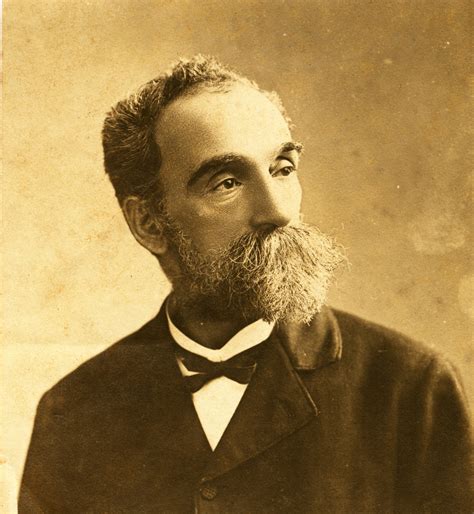
Eugenio Maria de Hostos
The Puerto Rican Autonomist Party was a political party founded by Román Baldorioty de Castro in 1887 in Ponce. The party sought to establish an independent government for Borikén under Spanish colonial rule. The party advocated for self-rule, but not independence from Spain. It envisioned decentralized control by Spain and a strong local government.
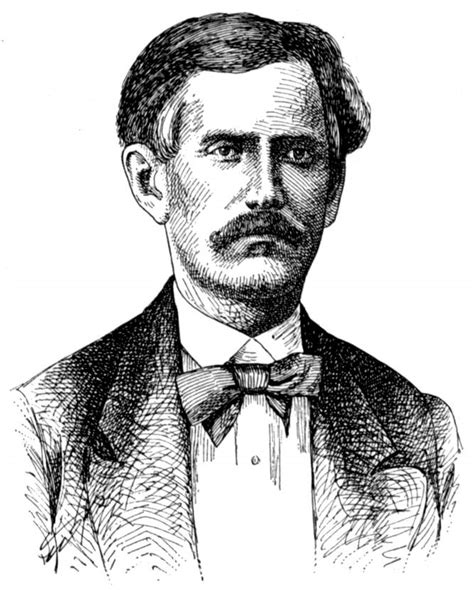
Román Baldorioty de Castro
The Intentona de Yauco (the “Attempted Coup of Yauco”) of March 1897 was the second and final major revolt against Spanish colonial rule in Puerto Rico, staged by the country’s pro-independence movement in the second half of the nineteenth. Although Intentona de Yauco did not succeed, it demonstrates our people’s attempts throughout history to fight for our freedom by any means necessary.
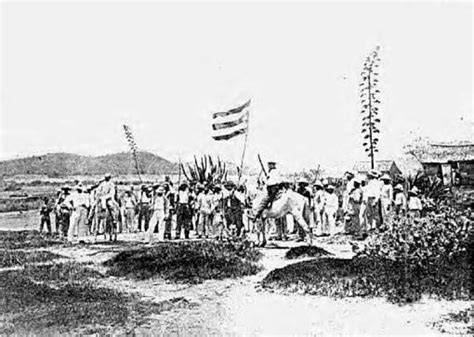
Intentona de Yauco
José de Diego Martínez, born on April 16, 1866 in Aguadilla, was a journalist, poet, lawyer, and most importantly an advocate for independence from Spain. He was also an advocate for the Antillean Confederation.
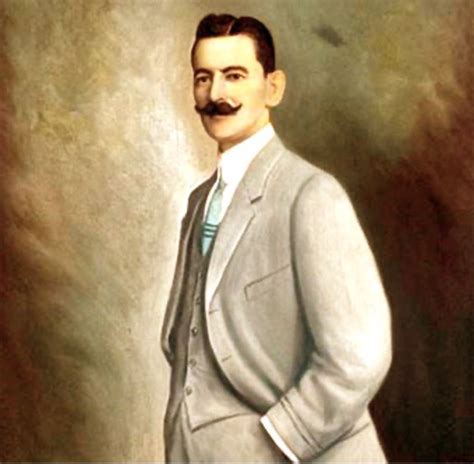
José de Diego Martínez
The US Invasion of Borikén
The Spanish-American War began in 1898 and was initiated by the explosion of the USS Maine in Havana Harbor. On July 25th, 1898 the US invaded Borikén at Guánica, led by General Nelson A. Miles, known for the mass murder of indigenous peoples on Turtle Island (the so-called US). Under the guise of the “Puerto Rico Campaign”, about 16,000 U.S. troops claimed to ‘liberate’ Borikén from Spain. Despite these claims, the US army was in fact conducting a full scale invasion of the archipelago and continues to occupy our country today.
In 1898, the Treaty of Paris ended the war, thus releasing control of Puerto Rico, Cuba, Guam, and the Philippines to the United States.
Shortly after the Treaty of Paris was signed, Juracán Ciriaco (Juracán is the Taíno word for hurricane) devastated Borikén. The US offered no aid and in 1901 passed the Hollander Bill, a land tax that forced farmers to mortgage their land with U.S. banks. The rates were too high so many jíbaros (farmers) lost their land. US banks forced jíbaros to focus entirely on producing a monoculture of sugar. The first US governor of Borikén was Charles Allen. Allen also happened to be the president of a large US sugar corporation, Domino Sugar. Under Allen, 45% of all arable land in Borikén was set to be used for sugar production and 80% of this land was U.S. owned.
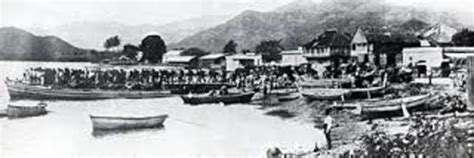
The arrival of the US in Guanica, Borikén in 1898
The Aftermath of the US Invasion and the Fight for Independence
Luisa Capetillo, born on October 28, 1879 in Arecibo, was an anarchist socialist, writer, and labor organizer. Often wearing suits and more masculine attire, Capetillo read newspapers for cigar workers, an important and highly respected position considering the large percentage of illiterate workers. She began her labor organizing with the Federación Libre del Trabajo (Free Federation of Laborers) founded by Santiago Iglesias Pantín in 1899. From 1905 onwards, she organized agricultural labor strikes in New York, Tampa, and Cuba. As a feminist, she fought for gender equality, women’s labor rights, and more. In 1911, she published Mi Opinión. In the book, Capetillo gives one of the first feminist expositions in Puerto Rico and Latin America more broadly. Capetillo argued for drastic changes in “all structures of social and economic domination so women could be truly liberated,” including in the workplace, education, marriage, and religion. She is widely overlooked, but more information is available in the works of Boricua scholar and philosopher Dr. Stephanie Rivera Berruz, a professor at Marquette University. Capetillo died from tuberculosis on April 10, 1922 in San Juan. Another incredible woman who fought for the rights of Boricua workers is Juana Colón, the daughter of freed slaves born on March 27, 1886 in Comerío.
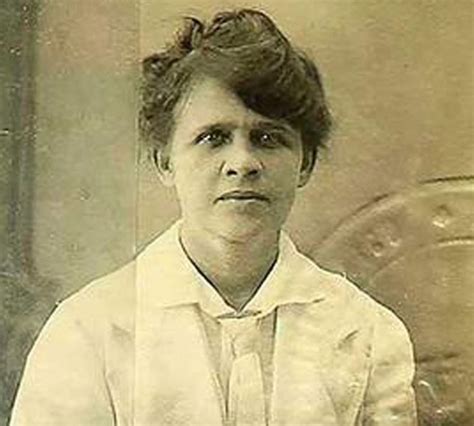
Luisa Capetillo
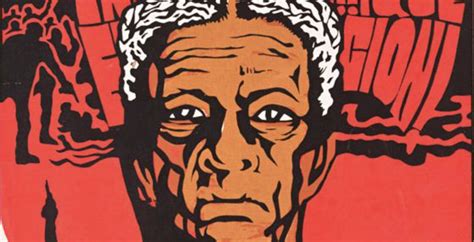
Juana Colón
In 1912, Rosendo Matienzo Cintrón, born on April 22, 1855 in Luquillo, founded the Partido Independentista Puertorriqueño, known in English as the Puerto Rican Independence Party (PIP). Cintrón was an advocate for Puerto Rican statehood, until he eventually realized that the United States would never serve the people as a state, nor a colony. He founded the party to fight for independence and released a manifesto. He died on December 13, 1913 in Luquillo.
In 1917, the US sought to impose citizenship on the Boricua people and to control imports using the Jones Act under President and war-criminal-in-chief Woodrow Wilson. The sole purpose for Boriqua’s receiving citizenship was to allow military conscription into the US’s imperialist wars and to avoid international scrutiny, beginning with World War I and continuing to the present. About 18,000 Boricuas served in World War I. These numbers are only estimates because the US military refused to keep data on the ethnicity of their soldiers at this time. The US also used about 335 Boricuas for chemical gas experimentation which were conducted as part of an active chemical weapons program in Panamá.
Luis Muñoz Rivera born on July 17, 1859 in Barranquitas, was a poet, journalist, and politician. He founded the Unionist Party in 1904 which was the first mass political party to push for independence from the United States. In 1917, his dying wish was for the Jones Act to be accepted, hoping that this would eventually move Borikén towards autonomy.
Antonio Rafael Barceló was born on April 15, 1868 in Fajardo. Barceló was a member of the Unionist Party and in 1922 he changed his party’s position from pro-independence to favoring an autonomous form of government similar to the Irish Free State. On September 17, 1922 the Independence Association became disillusioned with the Unionist Party’s recent decision and merged with José Coll y Cuchí’s Nationalist Association of Puerto Rico and the Juventud Nacionalista (Nationalist Youth), forming the Partido Nacionalista de Puerto Rico (Nationalist Party of Puerto Rico).
In 1926, President and war-criminal-in-chief Calvin Coolidge appointed Fredrick Holcomb as auditor of Borikén. This is important because Holcomb was also the auditor for the United Fruit Company. The United Fruit Company committed numerous crimes against indigenous and working people in Latin America and the Caribbean.
In 1927, “La Operación” began. One-third of Boricua women were sterilized without receiving prior informed consent. The sterilization of Boricua women was normalized so much so that even inside of the factories where women worked, sterilization clinics were onsite so women could receive the surgery for free during their lunch breaks. Dr. Cornelius Rhodes, a eugenist doctor from the US, used his Boricua patients as test subjects to study anemia and other diseases. Rhodes admitted to infecting and even refusing treatment to certain patients as part of his research. Letters revealed his genocidal sentiments towards the Boricua people and his efforts to exterminate as many as he could. There is a documentary detailing this history called “La Operación” by Ana María García.
Luis Muñoz Marín was born on February 18, 1898 in Viejo San Juan. He later became the first Boricua governor of Puerto Rico. Alongside Barceló, Muñoz Marín was a member of El Partido Liberal (the Liberal Party), created in 1932.
Muñoz Marín gained recognition and favor from US politicians while he visited Washington DC. He championed the New Deal, insisting that Borikén would benefit economically from the federal policy. When independence was proposed in
El Partido Liberal, there was a falling out. Muñoz Marín and his followers rejected independence, believing Borikén would benefit economically by remaining a colony of the US. The FBI used secretive information on Muñoz Marín to
manipulate him into making decisions partial to US interests. Eventually, el Partido Popular Democrático (the Popular Democratic Party) was founded. Muñoz Marín is responsible for the current name and legal relationship between Borikén
and the United States. According to the US empire, Puerto Rico is an “Associated Free State” (Estado Libre Asociado), a title adopted by a constitutional assembly on July, 25 1952. This led to the US Supreme Court declaring Borikén
an unincorporated ‘territory’. Despite the intentional confusion surrounding Borikén’s political status, it is clear these efforts are merely designed to hide the truth; Borikén is a colony of the United States.
The conditions of Borikén during much of the 20th century were deplorable. Unions were prohibited, employment rates were high, and those who did work were hyper-exploited. Many Boricuas were dying of starvation due to low wages and
the loss of the island’s food production. Land was stolen from farmers and either turned into sugar plantations or factories to feed the US mainland. The imperialist and capitalist class had free reign to exploit Boricuas under the
protection of US rule.
The terrible living conditions in Borikén pushed many poor and working class Boricuas to support the Partido Nacionalista de Puerto Rico (PNPR). The PNPR fought for the independence of Borikén and was led by Pedro Albizu Campos or “El Maestro”. He was the first Boricua graduate of Harvard Law School, he spoke six languages, and had the highest GPA of his graduating class. Albizu Campos served two years in the US military where he experienced racism for being Afro-Boricua. He became disillusioned with the US while he was in the military and eventually moved back to Ponce to become a people’s lawyer (serving mostly sugar cane workers and jíbaros). He was an internationalist and helped draft the constitution for the Irish Free State and worked alongside Mahadev Desai, a leader of the Indian anti-imperialist movement. Between 1927 and 1930, he traveled to Cuba, Panamá, México, Venezuela, Peru, the Dominican Republic, and Haiti to advocate for Borikén’s independence. In 1930, Albizu Campos was elected as the president of PNPR. PNPR supported the tactical use of armed struggle to gain international attention for Borikén as a colony and as a means to achieve independence.
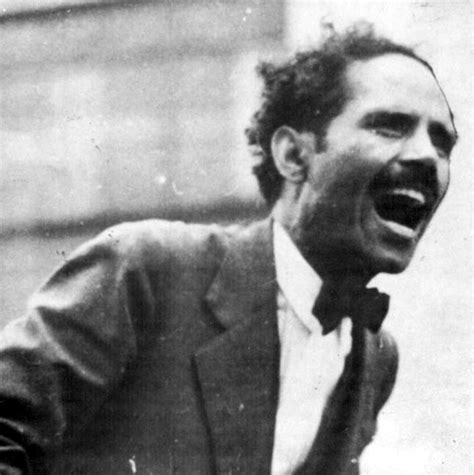
Don Pedro Albizu Campos
In 1931, Cornelius P. Rhoads (“Dusty” Rhoads) was commissioned by the Rockefeller Institute to conduct clinical research at Presbyterian Hospital in San Juan, Puerto Rico. The initiative came about as high rates of anemia caused by hookworms ravaged the country. A letter (shown below) was found at the hotel Rhoads was staying at, which stated his thoughts about Boricuas calling us “the dirtiest, laziest, most degenerate and thievish race of men ever inhabiting the sphere” and his admittance of attempted genocide by injecting multiple Boricuas with cancer. This letter was later redistributed across Puerto Rico by Pedro Albizu Campos. He was never charged with any crime, made the cover of Time Magazine, had an award named after him with the American Association for Cancer Research, and died peacefully in Connecticut in 1959.
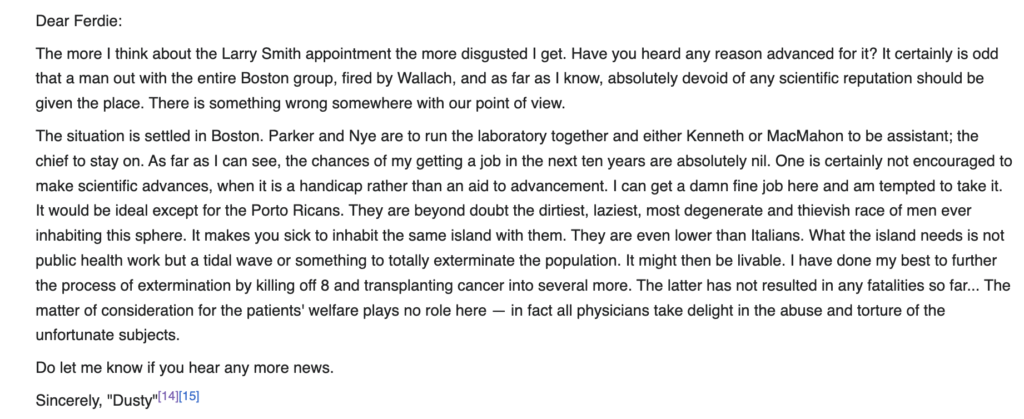
Francis E. Riggs became the appointed police chief of Puerto Rico in 1933 by war criminal Franklin D. Roosevelt. Riggs had a background working at the Military Intelligence Department in Washington DC and was the former advisor to Somoza, who later became the dictator of Nicaragua. The Riggs family owned Riggs Bank (now PNC Bank) located in Washington, DC. The Riggs Bank is responsible for funding numerous right wing coupes across the global south.
In 1934, Pedro Albizu Campos gave a fiery speech to thousands of sugar cane workers on strike. Francis E. Riggs called for a meeting with Albizu Campos, where Riggs offered by him a $150,000 donation to PNPR, a guaranteed seat in the senate, and the opportunity to be Governor of Borikén. Albizu Campos refused the offer and ended the meeting by saying “Puerto Rico is not for sale, at least not by me,” referring to Muñoz Marín, who did sell out Borikén and is known today in our country as a ‘vendepatria’ (a sellout). Following the meeting, Riggs threatened all Boricuas by saying “there will be a war to the death against all Puerto Ricans” if Albizu Campos did not stop ‘agitating’ the sugarcane workers. This did not deter Albizu Campos. From then on, war criminal Herbert Hoover ordered Albizu Campos to be followed and surveilled at all times by the FBI.
On October 24, 1935, five members of the Puerto Rican Nationalist Party (PNPR) were on their way to a meeting at the University of Puerto Rico in Río Piedras when they were stopped by local police. The police opened fire, killing four of the five members. This event is known as the Río Piedras Massacre and took a serious toll on the independence movement at the time.
In 1936, Francis E. Riggs was killed by two members of the PNPR, Elías Beauchamp and Hiram Rosado. The two sent a clear message; Boricuas are ready to fight to the death for sovereignty. The two party members were jailed and later murdered without trial. The murders enraged many Boricuas, regardless of party affiliation. Also in 1936, Albizu Campos met with Juan Antonio Corrtejer, (born on March 3, 1908 in Ciales) who became the Secretary General of the PNPR. Juan Antonio Corrtejer was an outstanding poet, journalist, and freedom fighter. Like many independentistas, Corrtejer traveled to many countries to gain support for Borikén liberation. Most notably, he traveled to Cuba, joining an anti-Batista group and assisted the Cuban people overthrow the US-backed right wing dictatorship. He died on January 19, 1985 in San Juan.
The Ponce Massacre occurred on Palm Sunday, March 21, 1937. On that day, the Puerto Rican Independence Party (PNPR) had planned a march through the city of Ponce. The march was led by the Liberation Army of Puerto Rico, the militant branch of el Partido Nacionalista (the Nationalist Party). While the group marched, police opened fire with tear gas, and live ammunition in revolvers, shotguns, and submachine guns. The police shot fired indiscriminately, even into a crowd of women, children, and bystanders that were watching the parade. 19 innocent people were murdered along with two police officers who died in the crossfire. An estimated 150 people were wounded. Cadet Bolívar Márquez Telechea used his own blood to write “¡Viva la República, Abajo los asesinos!” (“Long live the Republic, Down with the Murderers!”). The police even put weapons into the hands of dead bodies, taking photos for the U.S. media to convince outsiders it was people in the parade who shot first. However, an investigation following the massacre proved, with picture evidence, that no one in the parade was armed. No police officer was charged with the murder of innocent Boricuas. This is a day we will never forget.

The Ponce Massacre
In the aftermath, Albizu Campos and eight nationalist cadets were arrested. During the prosecution, a jury of seven Boricuas and five Americans were unable to reach a unanimous verdict, voting 7-5 for acquittal. A second jury, this time composed of ten Americans and two Boricuas, concluded Albizu Campos and the eight cadets were guilty. A member of the Socialist Party of America, Rockwell Kent, had evidence that the second jury for Albizu Campos’ case would be handpicked to ensure a guilty verdict. The media ignored the information and later that year, Albizu Campos was sentenced to ten years in prison in Georgia. After his release, Albizu Campos returned to Borikén in 1947 and gave a speech to 14,000 Boricuas. During this time, Operation Bootstrap was well under way, industrializing the island and creating tax exemptions for Americans and the wealthy. Boricua men were drafted to fight in the US’s wars and while the women were sent to work in factories.
In 1948, the Gag Law or La Ley de la Mordaza was passed, making it a felony to display or own a Boricua flag, sing the original Borinqueña, and talk, read, and publish/sell anything related to independence. The Gag Law resulted in 3,000 Boricuas being imprisoned, some spending more than 20 years in prison.
Starting on October 29th 1950, the nationalist party led an island-wide uprising against US occupation, first in the town of Peñuelas. The next day, October 30th, five nationalists attempted to kill Luis Muñoz Marín during the Jayuya Uprising. The Boricua nationalists staged uprisings in several towns: Peñuelas, Ponce, Mayagüez, Naranjito, Arecibo, Utuado, San Juan, and Jayuya. In Jayuya, Blanca Canales and Griselio Torresola Roura led armed nationalists in an attack against the local police station. A shootout with the police occurred, killing one officer and wounding three others before the group surrendered. The nationalists cut telephone lines and burned post offices. Canales led the group into the town square where a light blue version of the Puerto Rican flag was raised in defiance to the Gag law. The US military, National Guard, FBI, CIA, and the Puerto Rican police retaliated by using aircrafts, land based artillery, mortar fire, grenades, and 500 pound bombs on Jayuya, utterly devastating the town.
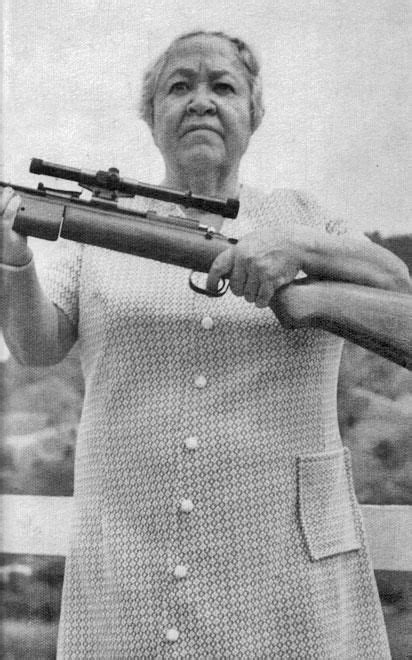
Blanca Canales during the Jayuya Uprising
Nationalists were arrested and killed and after a day-long shoot out, Albizu Campos and many others were arrested and taken to La Princesa prison. La Princesa was a testing facility for chemical and radiological torture. While in prison, Albizu Campos, along with many other Nationalist prisoners, were trapped in solitary confinement and were subjected to radiological torture. In 1956, Albizu Campos suffered a stroke while in prison and was transferred to a hospital. After decades of suffering psychological and radiological torture, Albizu Campos was near dearth when Muñoz Marín pardoned him in 1964. Pedro Albizu Campos soon passed away on April 21, 1965. More than 75,000 Boricuas attended his funeral in Viejo San Juan.
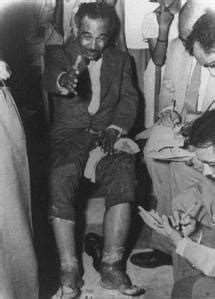
Don Pedro Albizu Campos, subjected to Total Body Irradiation (TBI) torture
On November 1, 1950, two members of the Nationalist Party, Oscar Collazo and Griselio Torresola (the same men who led the Jayuya Uprising), attempted to assassinate war criminal Harry S. Truman at the Blair House in Washington DC. During the shootout with the police, Torresola killed one White House police officer, but before the officer’s death, he fired back killing Torresola. Collazo was wounded and arrested; he was convicted of murder and sentenced to death. Later, Truman commuted his punishment to life imprisonment and during the Carter Administration, Collazo was released on parole and returned to Puerto Rico.
On March 1, 1954, four members of el Partido Nacionalista de Puerto Rico (PNPR), Rafael Cancel Miranda, Irvin Flores, Andres Figueroa Cordero , and Lolita Lebrón, traveled from New York City to Washington DC. They entered the House of Representatives, opening fire and wounding several within the building. Lebrón cried out, “Viva Puerto Rico Libre!” while waving a Puerto Rican flag. This particular date was chosen because it coincided with the inauguration of the Conferencia Interamericana (Inter American Conference) in Caracas, Venezuela. Their attack was designed to bring attention to the status of Puerto Rico as a colony and the ongoing struggle for independence.
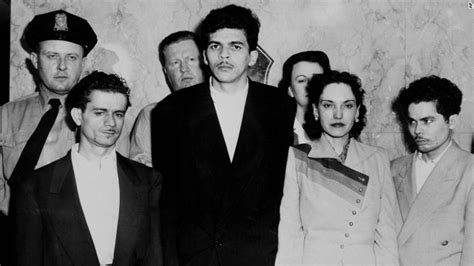
The 1954 Congress Attack
Between 1956 and 1971, Boricuas, the Young Lords, the Black Panther Party, the American Indian Movement, and other radical liberation groups were surveilled, infiltrated, and disrupted by the FBI under the covert and illegal Counter Intelligence Program (COINTELPRO). For Puerto Rico specifically, ‘ las carpetas’ was a massive surveillance program used against Boricuas, dating back to the mid-1930s.
The Puerto Rican Socialist Party originated from the Movimiento Pro-Independencia (MPI), founded on January 11, 1959, in Mayagüez. The MPI was formed by a group of dissidents from the Puerto Rican Independence Party (PIP), former militants of the el Partido Nacionalista de Puerto Rico (PNPR), the Communist Party of Puerto Rico, and university students members of el Federación de Universitarios Pro Independencia (FUPI). The MPI included figures such as Lidia Barreto, Rafael Cancel Rodríguez, Loida Figueroa Mercado, and Juan Mari Brás, among many others. At its Eighth General Assembly on November 28, 1971, the MPI transformed into the Puerto Rican Socialist Party (PSP), an organization that eventually chapters in New York City and Chicago. The PSP created La Claridad, a newspaper designed to disseminate accurate and critical information to working class Boricuas. La Claridad still exists today, although no longer in its exclusively socialist form. “La alternativa socialista”, the 1974 political thesis of the PSP, argued that united worker power was necessary to provoke a crisis of the colonial system in Puerto Rico and that independence would emerge from this crisis. The movement disbanded in 1993.
In 1971, protests were held in Culebra (one of the three inhabited islands in the archipelago) to push out the US Navy. The Navy was using Culebra and Vieques (another inhabited island of Puerto Rico) for military training, including ship-to-shore maneuvers, aerial bombardment, proving grounds, and more. Rubén Berríos, born on June 21, 1939, was the former president of the PIP and a key leader during the fight to remove the military from Vieques and Culebra. During the protests, Berríos and 13 other protestors were arrested and charged with trespassing on US military property. They were sentenced to three months in prison. Military operations ceased in Culebra and were moved to Vieques in 1975.
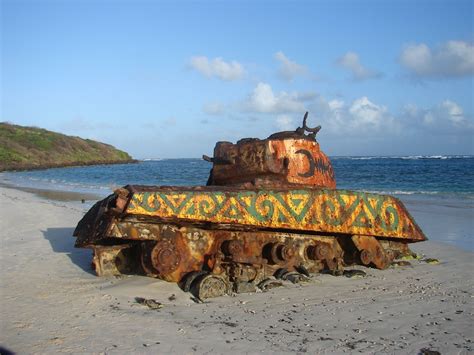
A US tank that remains in Culebra today
In 1976, the Ejercito Popular Boricua (the Boricua Popular Army), known as the Macheteros was founded by Filiberto Ojeda Ríos. Ojeda Ríos was born on April 26, 1933 in Naguabo. He was an excellent trumpet player before becoming the leader of the Macheteros, a clandestine militant organization fighting for the liberation of Borikén. Their two most notable actions were the Wells Fargo bank robbery of 1983, where 7.1 million dollars were liberated from the bank on Pedro Albizu Campos’s birthday, and the 1981 Muñiz Air National Guard Base attack on Eugenio María de Hostos’s birthday.

Macheteros Logo
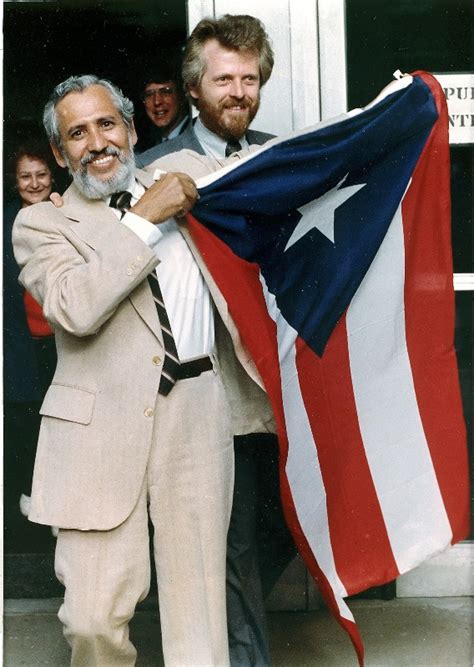
Filiberto Ojeda Ríos

On July 25, 1978, two Boricua independence fighters were killed in a police ambush known as the Cerro Maravilla murders. Carlos Enrique Soto-Arriví and Arnaldo Darío Rosado-Torres planned to seize control of the radio towers on the mountain and read a manifesto protesting the imprisonment of nationalist political prisoners and the anniversary of the United States’ invasion of Borikén, which occurred on the same day in 1898. Soto-Arriví and Dario Rosado were tricked by an undercover police officer, Alejandro González Malavé, who infiltrated their organization and pretended to be a member of their party. Before the two men reached the towers, they were ambushed and killed by multiple police officers. A following investigation, led by the local Justice Department, the FBI, and the US Justice Department, found no wrong doings in the murders.
El Colectivo de Medios y Propaganda del Movimiento Socialista de Trabajadoras y Trabajadores, or the Media and Propaganda Collective of the Socialist Workers’ Movement (MST), was formed in 1982 by the merging of two important (and previously rival) socialist groups, the Maoist Partido Socialista Revolucionario (PSR) and the Guevarist/Marxist-Leninist Movimiento Socialista Popular (Popular Socialist Movement).Later in 1984, the Liga Internacionalista de los Trabajadores (Workers’ Internationalist League) also merged into the MST. Influenced by Che Guevara and Mao Zedong, along with several other international socialist revolutions, the MST began to replace the declining Puerto Rican Socialist Party (PSP). The MST created a newspaper known as the Bandera Roja to share free information to students, workers, and people in poverty.
In 1990, the MST founded the Socialist Front along with El Partido Revolucionario de los Trabajadores Puertorriqueños-Macheteros, or the Puerto Rican Revolutionary Workers’ Party-Macheteros, (PRTP-Macheteros) and El Taller de Formación Política, the Political Education Workshop (TFP), creating an alliance of radical-left groups. Among its supporters were Rafael Feliciano Hernández, the twice-elected leader of the Teachers’ Federation of Puerto Rico, Victor Rodríguez, student leader and spokesperson for the Union of Socialist Youths (UJS) at the University of Puerto Rico in Río Piedras, and Pedro Colón Almenas, an anti-military activist, student organizer, and former political prisoner.
By the 1990s, the Puerto Rican Nationalist Party had moved far right after Pedro Albizu Campos’s death. The group became a US sympathizer party, supporting US policy programs such as the ‘war on crime’. We recognize that crime is inextricably linked to poverty. To support a ‘war on crime’ is to support the militarization of the police, private property over human life, and an endless war against the poor.
Early 2000s and the Current Situation of Borikén
In 2003, Vieques was freed by the people after decades of struggle against the US Navy, who was using the island as
a testing ground. The struggle against the military even included organizers occupying the Naval base multiple times. The military practiced ship-to-shore maneuvers and tested bombs, chaff, uranium, and Agent Orange (to later
be used on the Vietnamese people) on Vieques. Although the military was tasked with cleaning up the waste and contamination they created during occupation, little has still been done. Today, undetonated bombs go off at any moment
and Viequenses suffer from higher rates of cancer than those in Borikén due to extreme levels of radiation and other contaminants. On top of this, there is no operating hospital in Vieques. Those seeking medical care must travel
by ferry to the mainland in order to access medical facilities. In 2020, a thirteen year old girl named Jaideliz Moreno Ventura from Vieques died after suffering from flu-like symptoms. Her family took her to the hospital on the
mainland, but was released that day after testing negative for influenza. Moreno Ventura and her family returned to Vieques, but a few days later her condition worsened. Her family took her to a local clinic in Vieques, but it was
not equipped to give her oxygen. She died the same day while in transit to the mainland hospital.
Tito Kayak, born in 1958 in Jayuya, was the founder of an environmental organization known as Amigos Del Mar (Friends of the Sea). He was known for his activism in Vieques against the US Navy and most notably for dropping a Puerto
Rican and Vieques flag on top of the Statue of Liberty in New York City in 2000. In 2007, Tito Kayak raised a Palestinian flag in the occupied West Bank.
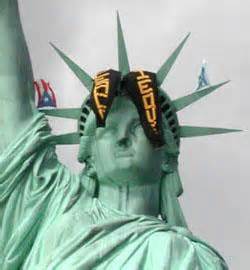
Tito Kayak on top of the Statue of Liberty

Vieques Protests
One year later, the Movimiento Independentista Nacional Hostosiano (MINH), a leftist and pro-independence organization in Puerto Rico, led discussions on the importance of Boricua solidarity and international solidarity.
On September 23, 2005, just past 3pm, Filberto Ojeda Ríos was shot by the FBI. The Hostage Rescue Team who had recently received commando training in Iraq, raided and killed Ojeda Ríos’s home in Hormigueros, who were supposed to be serving a warrant for his arrest. Elma Beatriz Rosado Barbosa, Ojeda Ríos’ wife, and their neighbor Héctor Reyes, stated that the FBI entered their house at 3pm, shooting and without warning. Ojeda Ríos returned fired and one agent was wounded. The FBI denied these accounts, claiming Ojeda Ríos fired on agents as they approached.
In 2006, US Code 936, a tax credit for businesses operating in Borikén, designed to attract and benefit foreign businesses, ended. Approximately 100,000 Boricuas became unemployed, causing a government shutdown for two weeks. Today, Borikén’s unemployment rates are over 16% (compared to the US mainland’s unemployment rate hovering around 3-4%) and the poverty rate is about 45% (soaringly higher than the US’s statistics).
Four years later, about 33,000 people lost government jobs and the average utility bill was 300% higher than the US average. To date, over 650+ public schools have been closed and there have been multiple failed attempts to privatize the University of Puerto Rico. These attempts have all been stopped due to the effective but not well known organizing of students from the Juventud Hostianos. All of these conditions continue to force Boricuas out of their homeland and into the diaspora.
In 2016, the Puerto Rico Oversight, Management, and Economic Stability Act (PROMESA), was established by the US Congress to create a financial oversight board for Puerto Rico. The goal was to restructure Puerto Rico’s “debt” and to expedite approval for certain infrastructure projects. Using PROMESA, Congress established an appointed Fiscal Control Board (FCB), known in Puerto Rico as “La Junta” to oversee the “debt” reconstruction. PROMESA is a primary tool of the US’s neocolonial rule over Borikén. La Junta’s fiscal austerity plan for 2017-2026 has attacked Puerto Rico’s public sector, including cuts to healthcare, social services, pensions, and education in order to repay large, corporate creditors and bond holders.
t’s important to recognize that the country of Borikén should not owe any money in debt, and should be provided with reparations for the 500+ years of colonization and genocide we have had to endure.
Puerto Rico pays the highest amount of taxes compared to any state ($73.7 billion between 1990-2009) but receives much less from the US government.
Oscar López-Rivera, born on January 6, 1943 in San Sebastián, is the longest held political prisoner in history. He was drafted into the US army at 18 after moving to Chicago with his family and served in the Vietnam War. Upon returning, he became an advocate for housing for the Puerto Rican community and later, an advocate for the independence of Puerto Rico. López-Rivera was a member and suspected leader of the Fuerzas Armadas de Liberación Nacional Puertorriqueña (FALN), a clandestine paramilitary organization devoted to Puerto Rican independence. The FALN carried out more than 130 bomb attacks in the United States between 1974 and 1983. He spent 36 years in prison, most of which was in solitary confinement. In January of 2017, he was released when his sentence was commuted by war criminal Barack Obama. López Rivera was one of the founders of Dr. Pedro Albizu Campos High School and the Juan Antonio Corretjer Puerto Rican Cultural Center. He also helped found FREE, a halfway house for convicted substance abusers and an educational program for Latinos that have been incarcerated at Stateville Prison in Illinois.
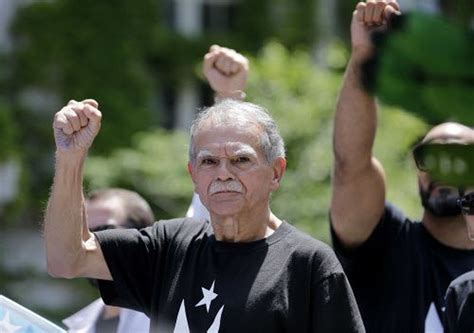
Oscar López Rivera
On September 20 2017, Hurricane Maria hit Borikén and other neighboring countries. Only weeks before, Hurricane Irma had hit on September 7th. Maria was a category 4/5 hurricane and it devastated our islands. Approximately 5,000 Boricuas died, however both the US and the Puerto Rican government fabricated much lower numbers. There was no power or running water across Puerto Rico for months. There was also no cellphone signal so people were unable to communicate with those of us in the diaspora. Maria destroyed most of our crops and left millions without homes. The Federal Emergency Management Agency (FEMA), failed to provide meaningful assistance and even left planes full of fresh drinking water and supplies sitting unloaded on tarmacs. The after effects of Hurricane Maria are still felt today, both in the people and the land.
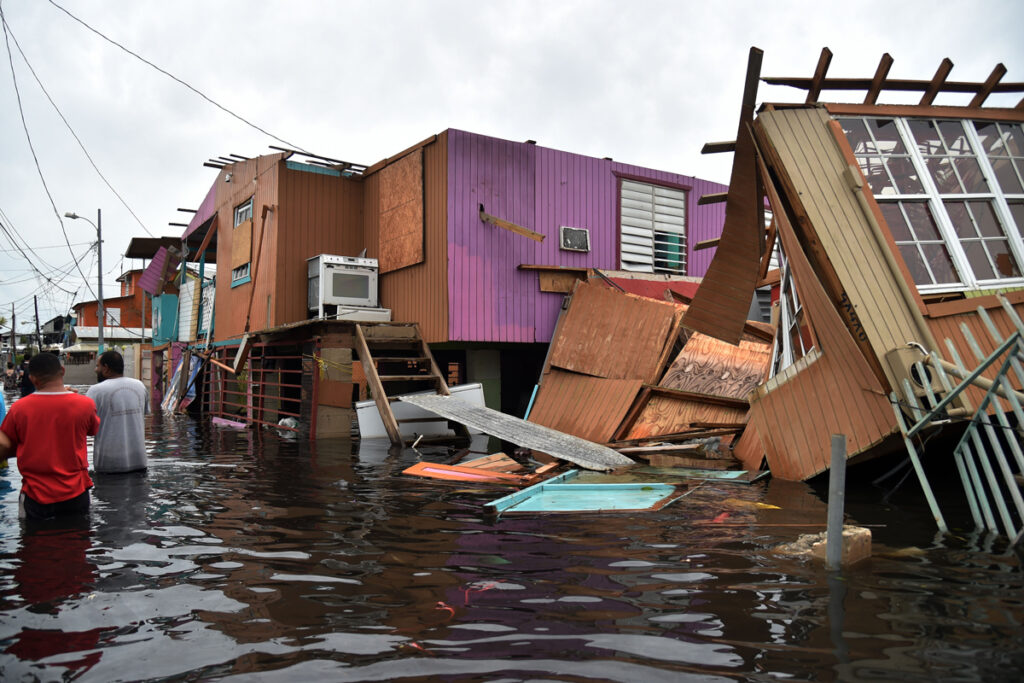
The devastation of Hurricane Maria
Ricardo Rosselló, the former governor of Puerto Rico from 2017-2019 was ousted by the people after the Telegram Gate Scandal. The Telegram Gate Scandal occurred when a WhatsApp chat full of vulgar, hateful, racist, and homophobic messages between Rosselló and cabinet members was leaked. Under Governor Rosselló, LUMA, an American/Canadian-owned utility company was tasked with privatizing the electrical power grid of Borikén. Since privatization, people’s energy bills have skyrocketed and blackouts, that can last for months on end, have become commonplace. These blackouts affect the island’s hospitals and people who relied on life supporting medical equipment have died due to the outages. Under LUMA, there have been fires at power plants and in people’s homes, resulting from faulty and poorly maintained electrical infrastructure. Wayne Stensby, the CEO of LUMA, fled Puerto Rico after a court ordered his arrest for failing to submit documentation surrounding LUMA’s activities. Rosselló was replaced by Wanda Vázquez Garced, who was later arrested in 2022 by the FBI on corruption charges in a bribery case connected to the 2020 gubernatorial campaign.
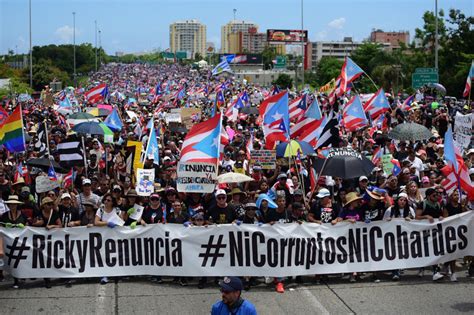
Protests calling for Rosselló’s resignation
Pedro Pierluisi, the current governor of Puerto Rico, was “elected” in 2020 after beating Garced in the elections. Under Pierluisi, conditions remain the same for most Boricuas while the government’s corruption allows people like Pierluisi to sell our lands and kill off our people.
Apart from the government’s corruption and poor living conditions, another issue in Puerto Rico is Ley 22 (Act 22), now called Ley 60 (Act 60). Ley 60, allows foreigners to move to our country and open businesses without paying capital gains taxes (this law only applies to foreigners). Vultures, such as Brock Pierce (a known pedophile), Logan Paul, and other “crypto-colonizers” (those who come to Borikén to sell and promote cryptocurrency) are examples of why Boricuas chant “Gringo Go Home”. These new age colonizers are contributing to the displacement of the native people and stealing our land. For additional information on the current displacement of Boricuas, check out Bianca Graulau on YouTube.
There is an ongoing debate in our country and across the diaspora regarding the question of Puerto Rico’s political status. There are two main sides: statehood for Puerto Rico and independence Puerto Rico. It is important to remember our colonial history and relationship to the US, especially when considering statehood. An example of statehood failing is the sovereign nation of Hawai’i. Hawai’i was invaded by the US and forced to become a state. Today, the native population continues to be displaced and the people and land are poisoned by the US Navy’s omnicidal negligence at military sites such as Red Hill.
After centuries of colonization, our people have developed a strong sense of machismo (misogyny), homophobia/transphobia, and colorism. Femicides, including the murder of trans people, in Borikén are the highest per capita rate in the world. More information about the femicides in Borikén can be found here and in a report by the American Civil Liberties Union here. It is our duty to unlearn and to speak out and organize against machismo, homophobia/transphobia, and colorism.
Hurricane Fiona, a category 4 hurricane, once again devastated Borikén and neighboring countries on September 18, 2022. Fiona created severe flooding and landslides and damaged critical infrastructure like main roads in the mountainside, bridges, water and electrical infrastructure and more. Due to LUMA’s failure to prepare the electrical grid for storms and its terrible response after Fiona hit, months went by with blackouts spanning the entire country. The deaths caused by this hurricane were different than those who died from Maria, a much more powerful hurricane. There is no official death count for Hurricane Fiona, but the numbers are estimated to be 25 people, if not more. People died during this hurricane mostly due to the blackouts. Protests began soon after the storm hit, demanding the resignation of Pedro Pierluisi and an end to the contract with LUMA.

The aftermath of Hurricane Fiona
Boricuas in our country and throughout the diaspora continue to fight for our liberation and sovereignty. New and creative alternatives to the government’s failed programs are constantly developing to meet the immediate needs of
the people such as: access to sustainable food, clean water, safe and affordable housing, education opportunities for the youth, and caring for our elders. Groups like
Casa Pueblo and
Plenitud PR are community spaces to teach people about the importance of food and land sovereignty while fighting to protect the environment.
Centro Solidario is a community space working to provide free medical care for people from Vieques. Groups in the diaspora like
New York Boricua Resistance organize and educate large numbers of Boricuas in New York City about the ongoing struggle in Borikén. International solidarity has and will always be necessary in the struggle for independence, liberation,
and beyond. As Boricua revolutionaries, we will continue to maintain and strengthen relationships with all oppressed peoples from Palestine, to Haiti, to Cuba, and more. Borikén will be free.
Pa’lante, Siempre Pa’lante.
